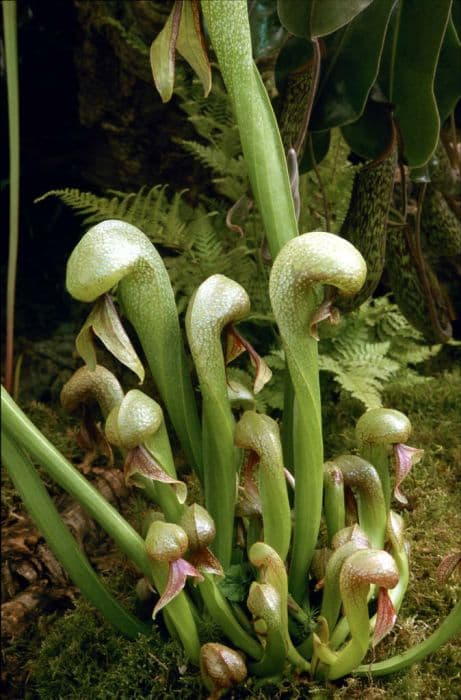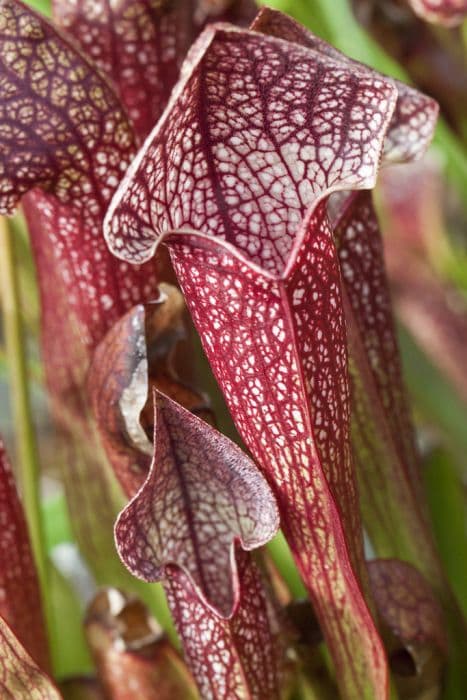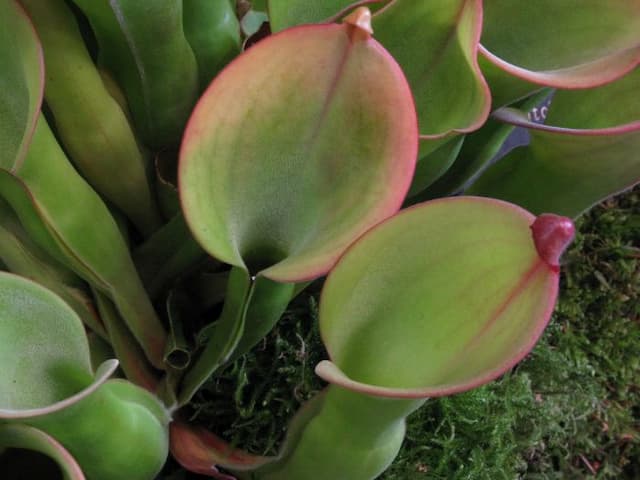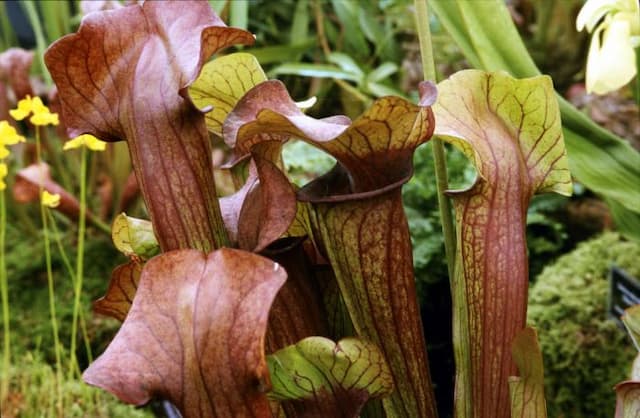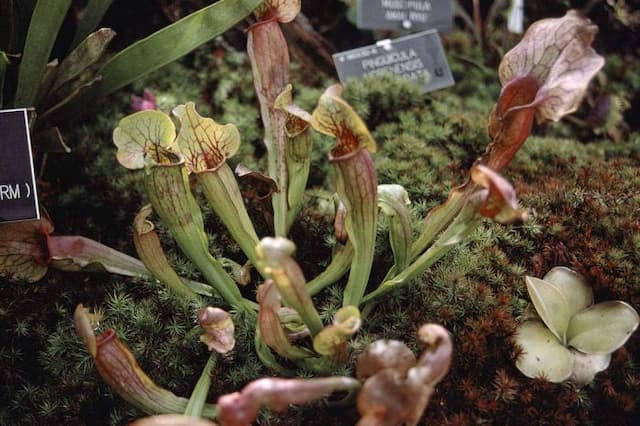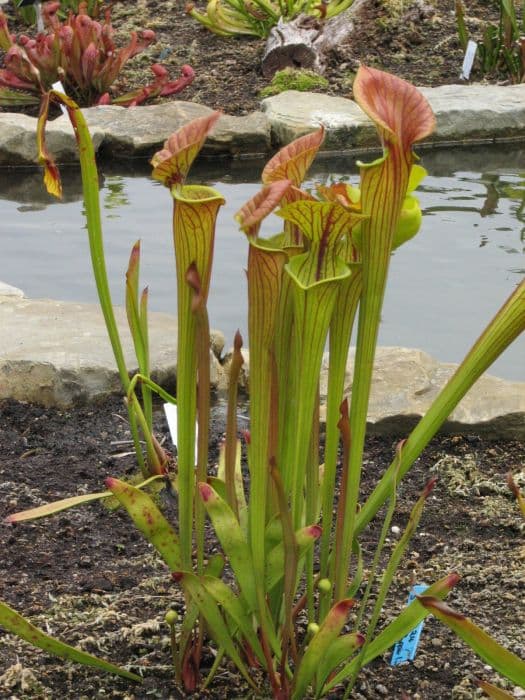Catesby's Pitcher Plant Sarracenia × catesbaei 'Violet'

ABOUT
Sarracenia × catesbaei 'Violet', commonly known as the Violet Pitcher Plant, is a distinctive and attractive carnivorous plant. Its most striking feature is the tubular, jug-like foliage known as pitchers, which are modified leaves designed to trap and digest insects. These pitchers are beautifully colored, displaying various shades of violet, often streaked or veined with contrasting hues that can include green, purple, or deep reds. Each pitcher typically has a flared hood or lid over its opening, which not only protects the interior from excess rainwater but also serves as a landing platform for unsuspecting insects. The inner walls of the pitchers are slippery and coated with downward-pointing hairs, making escape virtually impossible for any creature that falls in. The rim around the opening, called the peristome, is often a lighter color and can produce nectar to lure in prey. Inside, the plant produces digestive enzymes to break down its insect meals. The flowers of the Violet Pitcher Plant are also noteworthy, bearing a striking appearance that contrasts with the pitchers. They rise on separate stalks and can have a range of colors, sometimes complementing the pitchers with similar violet tones or having a completely different palette of yellows, reds, or greens. The flowers possess a unique, umbrella-like structure with petals dangling beneath. Overall, Violet Pitcher Plants present a fascinating and slightly alien aesthetic with both their carnivorous pitchers and their unique flowers contributing to their visual appeal.
About this plant
 Names
NamesFamily
Sarraceniaceae
Synonyms
Catesby's Pitcher Plant, Hybrid Pitcher Plant
Common names
Sarracenia × catesbaei 'Violet'.
 Toxicity
ToxicityTo humans
Sarracenia × catesbaei 'Violet', commonly known as the pitcher plant, is not considered toxic to humans. There are no well-documented cases of poisoning from ingesting parts of this plant. However, as with any non-food plants, it is generally advised not to ingest them because individual sensitivity to plant compounds can vary, and there might be an unexpected reaction.
To pets
The pitcher plant is also not considered toxic to pets. There is no evidence suggesting that ingestion of Sarracenia × catesbaei 'Violet' will lead to poisoning or adverse health effects in pets. However, pets should not be encouraged to eat ornamental plants as a precaution against potential individual sensitivities or digestive issues.
 Characteristics
CharacteristicsLife cycle
Perennials
Foliage type
Deciduous
Color of leaves
Green
Flower color
Violet
Height
1-2 feet (30-60 cm)
Spread
1 foot (30 cm)
Plant type
Herb
Hardiness zones
6
Native area
Southeastern United States
Benefits
 General Benefits
General Benefits- Attracts Wildlife: Sarracenia × catesbaei 'Violet', commonly known as Pitcher Plant, attracts pollinators and provides a habitat for beneficial insects.
- Pest Control: This carnivorous plant helps to naturally control the population of pests such as flies and mosquitoes.
- Educational Interest: The Pitcher Plant's unique mechanism for trapping and digesting insects can serve as an educational tool for teaching about plant adaptation and evolution.
- Garden Aesthetics: With its vibrant violet pitchers, the Pitcher Plant adds unique visual interest and beauty to gardens and terrariums.
- Low Maintenance: As a carnivorous plant adapted to nutrient-poor environments, it requires minimal fertilization, making it a low-maintenance addition to plant collections.
- Conservation: Growing Pitcher Plants can contribute to the conservation of these unique species by reducing the pressure on wild populations.
- Hobby Interest: Cultivating Pitcher Plants can be a rewarding hobby for enthusiasts interested in their unusual growth habits and care requirements.
 Medical Properties
Medical PropertiesThis plant is not used for medical purposes.
 Air-purifying Qualities
Air-purifying QualitiesThis plant is not specifically known for air purifying qualities.
 Other Uses
Other Uses- Photography Subject: The unique appearance of the pitcher plant, with its vibrant colors and intricate shapes, makes it a fascinating subject for photographers and artists, particularly those interested in macro and nature photography.
- Educational Tool: Biology teachers and educators can use Sarracenia × catesbaei 'Violet' to illustrate botany concepts such as adaptation, evolution, and plant-insect interactions due to their carnivorous nature.
- Conservation Ambassador: These plants can serve to raise awareness about the importance of conserving wetlands and peat bogs, which are their natural habitats.
- Theme Gardens: Pitcher plants are ideal for creating thematic gardens such as a bog garden or a carnivorous plant display.
- Artistic Inspiration: Artists may draw inspiration from the unique form and vivid colors of the pitcher plant for various forms of artwork, including paintings, sculptures, and textile designs.
- Collectors’ Item: The rarity and uniqueness of different hybrids make pitcher plants like this one desirable to plant collectors and enthusiasts.
- Nature Study: Entomologists and ecologists can study the plant's trapping mechanisms and prey preferences as a part of ecological research.
- Biological Pest Control: While not commonly used for this purpose, pitcher plants can capture and reduce the local population of certain insects, potentially serving as a biological pest control agent in gardens.
- Hobby Cultivation: Growing pitcher plants like Sarracenia × catesbaei 'Violet' can be a rewarding hobby that challenges gardeners to replicate their specific growing conditions.
- DIY Projects: Crafty individuals may use dried or preserved pitcher plants for various do-it-yourself projects, such as creating botanical art or decorating terrariums.
Interesting Facts
 Feng Shui
Feng ShuiThe Pitcher Plant is not used in Feng Shui practice.
 Zodiac Sign Compitability
Zodiac Sign CompitabilityThe Pitcher Plant is not used in astrology practice.
 Plant Symbolism
Plant Symbolism- Adaptation: The Sarracenia × catesbaei 'Violet', also known as the Pitcher Plant, is well adapted to its environment, symbolizing the ability to thrive in difficult conditions.
- Attraction: With its bright coloration and trapping mechanisms, it symbolizes the power of attraction and allure.
- Mystery: The inner workings of the Pitcher Plant are not immediately apparent, symbolizing mystery and the unknown.
- Uniqueness: As a hybrid plant, it represents uniqueness and the blending of traits to create something new and extraordinary.
 Water
WaterThe Sarracenia × catesbaei 'Violet', commonly known as the Pitcher Plant, should be watered generously to keep the soil consistently moist, mimicking its natural boggy habitat. It's best to use distilled water, rainwater, or reverse osmosis water because Pitcher Plants are sensitive to minerals commonly found in tap water. Provide water until it begins to drain out of the bottom, ensuring the potting mix is thoroughly saturated. During the growing season in spring and summer, watering may be necessary once or twice a week. In the winter, reduce watering to every other week or when the soil barely starts to dry out.
 Light
LightPitcher Plant requires full sun to partial shade. The ideal location is where it can receive direct sunlight for several hours a day, particularly during the morning, with some protection from the intense afternoon sun which can scorch the leaves. A sunny windowsill or a spot in a sunroom with bright, indirect light for the rest of the day would be perfect.
 Temperature
TemperaturePitcher Plants thrive in temperatures between 70°F and 90°F during the day. However, they can tolerate temperatures as low as 40°F at night. They require a winter dormancy period with temperatures between 32°F and 50°F to simulate their natural environment and ensure healthy growth in spring. Extreme temperatures above 95°F or below freezing should be avoided to prevent damage to the plant.
 Pruning
PruningPruning Pitcher Plants helps to remove dead or decaying pitchers and promotes healthier growth. Prune away dead foliage during late winter or early spring before new growth starts. Do this maintenance once a year, using sterilized scissors or pruning shears. Cutting back the brown, spent pitchers and any dead leaves will encourage the plant to produce fresh, vigorous pitchers and foliage in the growing season.
 Cleaning
CleaningAs needed
 Soil
SoilThe best soil mix for the Catesby's pitcher plant is a combination of 60% peat moss and 40% perlite or sand. This plant requires acidic conditions, so the soil pH should be kept between 4.0 and 5.5 for optimal growth.
 Repotting
RepottingCatesby's pitcher plants should typically be repotted every 2-3 years to refresh the soil and accommodate growth. It's best to repot in the early spring before new growth begins.
 Humidity & Misting
Humidity & MistingCatesby's pitcher plants thrive in high humidity levels, ideally around 60-80%. They flourish in a moist environment that mimics their natural bog habitat.
 Suitable locations
Suitable locationsIndoor
Place in bright light, keep soil moist, and maintain high humidity.
Outdoor
Full sun to partial shade, very moist soil, high humidity.
Hardiness zone
6-8 USDA
 Life cycle
Life cycleSarracenia × catesbaei 'Violet', commonly known as the Catesby's pitcher plant or Southern pitcher plant, begins its life cycle with seed germination, which occurs in moist, acidic soils where conditions are appropriate. Seedlings emerge and develop a rosette of small pitchers and a root system to absorb nutrients from the soil and trap insects. As the plant matures, it produces larger and more vibrant pitchers each season, which are modified leaves functioning as pitfall traps to capture prey, providing the plant with additional nutrition. Throughout the growing season, which is typically spring through fall, it undergoes vegetative growth and may also propagate asexually by production of rhizomes or offshoots. During the reproductive stage, usually in the spring, the plant produces tall flower stalks bearing visually striking, yet malodorous flowers designed to attract pollinators like flies. After pollination and seed set, the plant enters a dormancy phase in the winter where growth slows down or ceases until favorable conditions return in the spring.
 Propogation
PropogationPropogation time
Spring
The most popular method of propagation for the Sarracenia × catesbaei 'Violet', commonly known as the hybrid Pitcher Plant, is through division. This process is best carried out in late winter to early spring, before the growing season begins. To propagate by division, carefully remove the plant from its pot and gently separate the rhizomes, making sure each division has at least one growth point. The divisions can then be potted individually in a mixture of peat moss and perlite, which should be kept moist but not waterlogged. Place the new pots in a location that receives bright, indirect light and maintains a high humidity level, as these conditions will facilitate root development and new growth.
